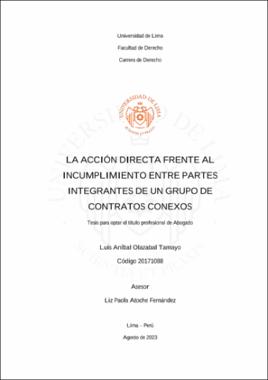La acción directa frente al incumplimiento entre partes integrantes de un grupo de contratos conexos

View/
Tesis
(application/pdf: 700.5Kb)
(application/pdf: 700.5Kb)
Autorización
(application/pdf: 310.3Kb)
(application/pdf: 310.3Kb)
Reporte de similitud
(application/pdf: 26.16Mb)
(application/pdf: 26.16Mb)
Date
2023Author(s)
Advisor(s)
Metadata
Show full item recordAbstract
The purpose of this investigation is to answer the following question: Is it possible to admit the use of the direct action for contractual connection in Peru? In this line, this paper will focus on analyzing whether a creditor -part of a group of related contracts- can exercise against a debtor -part of the same group of contracts- the contractual remedies derived from the breach of the latter, even if there is no contract between them. In order to do so, the origin of the contractual connection as a legal concept and its development in comparative law will be discussed. Subsequently, the nature of the direct action, its characteristics and scope will be analyzed in depth. Then, I will review the way in which the contractual connection has been approached in Peru by the doctrine and jurisprudence, as well as its indirect recognition at the regulatory level. Finally, on the basis of the aforementioned development, I will determine the feasibility of recognizing the use of the direct action against the breach of the parties of a group of related contracts, according to the current regulation of the Peruvian Civil Code. This analysis will be accompanied by an evaluation of: (i) whether it is necessary to amend the Civil Code in order to allow the application of this figure; and, (ii) what would be the practical implications of the use of the direct action in Peru. El presente trabajo tiene como finalidad responder la siguiente pregunta: ¿Es posible
admitir el uso de la acción directa por conexidad contractual en el Perú? En tal sentido, este trabajo se centrará en analizar si un acreedor –parte de un grupo de contratos conexos– puede ejercer frente a un deudor –parte del mismo grupo de contratos– los remedios contractuales derivados del incumplimiento de este último, aunque no medie entre ellos contrato alguno. Para ello, en primer lugar, se aborda el origen de la conexidad contractual como figura jurídica y el desarrollo que ha tenido en el derecho comparado. Posteriormente, se profundizará en la naturaleza de la acción directa, sus características y alcances. Luego, se revisará la forma en la que la conexidad contractual ha sido abordada en el Perú por la doctrina y jurisprudencia, así como su reconocimiento indirecto a nivel normativo. Finalmente, sobre la base del desarrollo antes señalado, se determinará la factibilidad de reconocer el uso de la acción directa frente al incumplimiento de las partes conformantes de un grupo de contratos conexos, según la regulación actual del Código Civil peruano. Dicho análisis será acompañado con una evaluación respecto a: (i) si es necesario que se modifique el Código Civil a fin de permitir la aplicación de esta figura; y, (ii) cuáles serían las implicancias prácticas del uso de la acción directa en el Perú.
How to cite
Olazabal Tamayo, L. A. (2023). La acción directa frente al incumplimiento entre partes integrantes de un grupo de contratos conexos [Tesis para optar el título profesional de Abogado, Universidad de Lima]. Repositorio institucional de la Universidad de Lima. https://hdl.handle.net/20.500.12724/20139Publisher
Universidad de LimaCollections
- Tesis [64]
